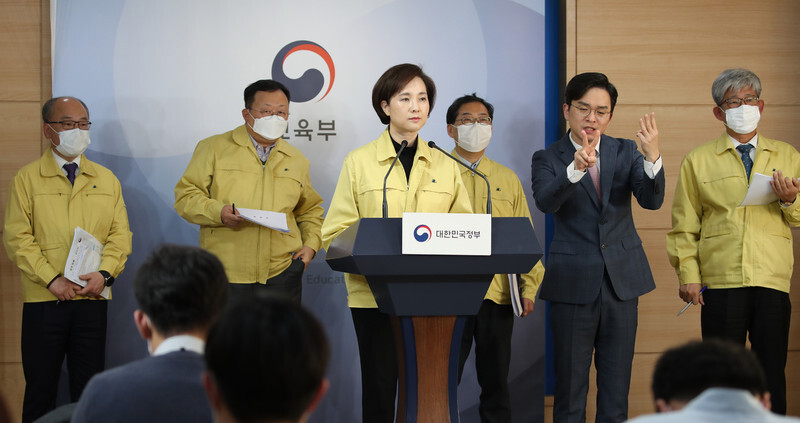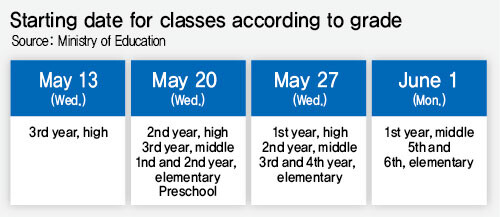hankyoreh
Links to other country sites 다른 나라 사이트 링크
S. Korean schools to begin reopening on May 13

After a delay of over two months in the face of the COVID-19 outbreak, South Korea’s schools will begin opening their classrooms on May 13. That’s the day that students in the third year of high school will return to the classroom. The other grades will follow suit in three phases, with a gap between each week, beginning on May 20.
The news was announced by Deputy Prime Minister and Education Minister Yoo Eun-hae during a briefing at the Central Government Complex in Seoul on the afternoon of May 4. “We’ve decided to allow kindergarten students and students in elementary, middle, and high school to start attending on-campus classes again on May 20, two weeks after we’ve integrated distancing into our everyday lives. But considering the urgency of students in the third year of high school preparing for college and their professional careers, those students will be allowed to return to school early, on May 13,” Yoo said.

The back-to-school schedule for each grade breaks down as follows. Students in the third year of high school are in the preliminary stage, returning to school on May 13. The first phase, on May 20, covers the second year of high school, third year of middle school, first and second grades of elementary school, and kindergarten; the second phase, on May 27, covers the first year of high school, the second year of middle school, and the third and fourth grades of elementary school; and the third phase, on June 1, covers the first grade of middle school and the fifth and sixth grades of elementary school.
The Ministry of Education (MOE) explained that its decision was based on “deliberations with the public health authorities and the opinions expressed by teachers in the classroom and students’ parents.” The position expressed by the public health authorities was that it would be appropriate for classes to resume at least 14 days after the long vacation in early May but that students in the third year of high school could return to school after just seven days, given their need to prepare for entering university or joining the workforce. Teachers and parents consulted by the MOE generally thought that students should return to school one or two weeks after the transition to a system of “everyday disease prevention,” and that classes should resume in phases, separated by schools and grades.
The MOE explained why middle and high schools will be accepting the oldest students first, while students in kindergarten and the lower elementary school grades will be returning to school before students in the higher elementary school grades. “We took into consideration how hard it is for kindergarten students and first and second graders in elementary school to adapt to remote learning, the education disparities created by parents’ financial situations, and the childcare burden online classes place on dual-income households. Furthermore, younger children [pose less of a risk of infection] because they have a narrower scope of activity and are easier for parents to look after.”
Originally scheduled to begin on Mar. 2, the spring semester was delayed because of the coronavirus outbreak. When the outbreak failed to subside, students started their semester online, taking classes at home instead of going to school, as part of a program that was phased in on Apr. 9. After the government announced that it would be transitioning to everyday disease prevention measures on May 6, the educational authorities announced its back-to-school schedule.
Schools and local education offices will have discretion to manage reopeningGiven the different conditions at each school, including the density of the student body and fluctuations in the outbreak in each region, the MOE will give individual schools and metropolitan and provincial education offices the discretion to decide exactly how to manage academic affairs once students return to school. Schools will have a range of options to choose from, such as staggering the times when each grade and class comes to school, having a mix of in-person and online education, assigning some classes to the morning and others to the afternoon, and taking a flexible approach to the length of classes.
Jung Eun-kyeong, director of Korea’s Centers for Disease Control and Prevention (KCDC), offered an explanation on Monday of the decision to send students back to school. “The number of cases [of COVID-19] occurring in the community has greatly decreased, falling below 10 a day since Apr. 20. That means the community risk is considerably lower than it used to be,” she said.
Jung also commented on the possibility of infection clusters occurring at schools after students return. “It’s not very likely, but we do think it’s possible and we’re preparing for that,” Jung said.
Jung added that students in the lower grades of elementary school present a greater risk of not obeying the distancing and hygiene rules than older students.
By Choi Won-hyung, staff reporter
Please direct comment or questions to [english@hani.co.kr]

Editorial・opinion
![[Column] When ‘fairness’ means hate and violence [Column] When ‘fairness’ means hate and violence](https://flexible.img.hani.co.kr/flexible/normal/500/300/imgdb/original/2024/0516/7417158465908824.jpg) [Column] When ‘fairness’ means hate and violence
[Column] When ‘fairness’ means hate and violence![[Editorial] Yoon must stop abusing authority to shield himself from investigation [Editorial] Yoon must stop abusing authority to shield himself from investigation](https://flexible.img.hani.co.kr/flexible/normal/500/300/imgdb/original/2024/0516/4417158464854198.jpg) [Editorial] Yoon must stop abusing authority to shield himself from investigation
[Editorial] Yoon must stop abusing authority to shield himself from investigation- [Column] US troop withdrawal from Korea could be the Acheson Line all over
- [Column] How to win back readers who’ve turned to YouTube for news
- [Column] Welcome to the president’s pity party
- [Editorial] Korea must respond firmly to Japan’s attempt to usurp Line
- [Editorial] Transfers of prosecutors investigating Korea’s first lady send chilling message
- [Column] Will Seoul’s ties with Moscow really recover on their own?
- [Column] Samsung’s ‘lost decade’ and Lee Jae-yong’s mismatched chopsticks
- [Correspondent’s column] The real reason the US is worried about Chinese ‘overcapacity’
Most viewed articles
- 1Could Korea’s Naver lose control of Line to Japan?
- 2[Column] Welcome to the president’s pity party
- 3[Column] US troop withdrawal from Korea could be the Acheson Line all over
- 4Naver’s union calls for action from government over possible Japanese buyout of Line
- 5[Editorial] Korea must respond firmly to Japan’s attempt to usurp Line
- 6Korea cedes No. 1 spot in overall shipbuilding competitiveness to China
- 7[Editorial] Yoon must stop abusing authority to shield himself from investigation
- 8[Column] When ‘fairness’ means hate and violence
- 9Korean opposition decries Line affair as price of Yoon’s ‘degrading’ diplomacy toward Japan
- 10Second suspect nabbed for gruesome murder of Korean in Thailand, 1 remains at large